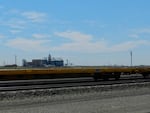The Oregon Department of Environmental Quality fined the Port of Morrow $1.3 million Tuesday for repeated wastewater violations that contaminated the groundwater in surrounding counties.
State regulators found the port, which runs an industrial park outside of Boardman, was overapplying wastewater containing nitrogen to agriculture fields and failing to monitor the resulting nitrate contamination.
The area is already burdened with groundwater pollution, according to DEQ, and the groundwater is used as the primary drinking water source for residents in Morrow and Umatilla counties.
The port has a water quality permit to collect nitrogen-rich wastewater from food processors, storage facilities, and data centers to use in irrigation on nearby farms.

A train snakes through the Port of Morrow.
Courtney Flatt
But according to DEQ, the port violated its permit more than a thousand times in four years by exceeding the limits on how much nitrogen it can apply and how much nitrate, a common fertilizer ingredient, can be in the soil prior to application.
The state says the port applied approximately 165 tons of excess nitrogen between 2018-2021, leading to extra nitrate in the area where levels already exceed the limit in their permit.
“These are serious violations of water quality regulations that are in place to protect public health and the environment,” DEQ deputy director Leah Feldon said in a press release. “The existing nitrate contamination in the basin’s groundwater means everyone in the region has to do their part to reduce this contamination. The Port of Morrow has not been doing its part.”
DEQ said nitrogen in the basin’s groundwater also comes from cow manure and fertilizers, but that’s separate from the port’s wastewater.
When used in appropriate amounts, nitrogen is considered an important and beneficial plant nutrient. But excess amounts of nitrogen can lead to high levels of nitrate, which is already found in soil, water, and air.
If it’s not used, the nitrate leaks into the soil and into the groundwater, where it can pose a health risk in drinking water sources. According to the Environmental Protection Agency, nitrate levels exceeding 10 milligrams per liter can cause serious health effects.
Drinking high levels of nitrate can lead to “blue baby syndrome,” which decreases the blood’s capacity to carry oxygen, especially in infants drinking baby formula mixed with contaminated water. Drinking water with excessive nitrate levels can also lead to respiratory infections, thyroid dysfunction and stomach or bladder cancer.
DEQ public affairs specialist Laura Gleim said contamination varies from location to location, and public drinking water systems are monitored and regulated to ensure safe drinking water for residents. But there is a problem for private well owners.
“There are no Oregon regulations on private wells, and so those folks are responsible for monitoring and maintaining their own drinking water, ensuring that it’s safe to drink,” she said.
One of those private well owners is Morrow County Commission Chair Jim Doherty who owns a well at his home west of Boardman. He said he had to get a filter system for his well because nitrate levels have exceeded healthy drinking water limits.
“I don’t drink my own drinking water and that is pretty sad,” he said.
Doherty said the high levels of nitrate found in groundwater are not all naturally occurring, and they don’t all come from one industry. He appreciates the work the port has done to bring in companies that provide jobs and strengthen the economy, he said, but he calls it a “double-edged sword” because those industries are harming the environment.
“We’re at a critical juncture where if we don’t slow down … and look at what we’re doing with our own environment and in our own area here, we’re not going to be sustainable,” he said.
Doherty said it might not be too late to reduce nitrate levels in groundwater. He said one of the main questions state and local agencies should ask is where the excess level of nitrogen is coming from and why.
“We’ve got to get to that base question of where did it originate and is it getting worse or is it getting better,” he said. “Frankly, it’s not getting better, but we really got to double our efforts to find out and figure out why.”
The Lower Umatilla Basin Groundwater Management Area, a committee charged with addressing the high levels of nitrate in groundwater, has identified five activities contributing to nitrate contamination: irrigated agriculture, food processing wastewater, animal feeding operations like dairies and feedlots, sewage from septic tank systems and the U.S. Army Umatilla Chemical Depot’s bomb washout lagoons.

Pie chart from the Lower Umatilla Basin Groundwater Management Area Local Action Plan that shows the estimate of nitrogen leached to the groundwater.
Oregon Department of Environmental Quality / Oregon Department of Enviromental Quality
The group has been working on an action plan to reduce nitrate contamination from food processors. Lamb Weston’s French fry plant, Oregon’s Potato Company and Boardman Foods’ onion processing plant are among the food processors that operate at the Port of Morrow, and their wastewater is high in nitrogen.
Gleim said DEQ will be working with the port to change their water quality permit to limit the amount of nitrogen-rich water that goes onto agriculture fields.
“That modification will require a schedule for the port to stop irrigation practices during the non-growing season,” she said. “This is like the winter season when crops use up much less nitrate than they do during the normal growing season.”
In November 2015, DEQ fined the port $279,000 for exceeding nitrogen limits in its permit. According to Gleim, DEQ and the port settled the case for $129,000 along with a corrective action schedule requiring the port to add additional field acreage to absorb the extra nitrogen.
In a press release statement, the port’s Executive Director Ryan Neal said they have been working cooperatively with DEQ on developing a long-term solution for the Port, industries, local farmers and the region.
